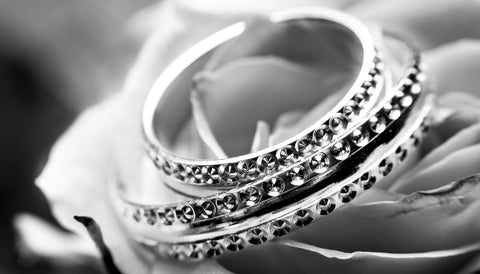From rings and bracelets to earrings and necklaces, diamonds can truly make your jewelry collection sparkle. But when you invest in these gemstones, you want to make sure they're genuine. Rather than getting a jeweler to examine your diamonds, you can find out if they're real from the comfort of your home. Find out how to spot a fake diamond with a few easy DIY tests.
What Does a Fake Diamond Look Like?

Image via Pexels by Pixabay
It's easy to assume that all real diamonds look the same, but that belief simply isn't true. Genuine diamonds naturally have a wide range of characteristics, including carat, cut, color, and clarity. These gemstones can be anywhere from a quarter of a carat to more than two carats, and they can reflect color notes ranging from yellow or red to blue or brown.
Because real diamonds have such a wide spectrum of qualities, it's easy to confuse a genuine gemstone with a knock-off — at least until you look closely. Some of the most common fake diamonds are actually one of these stones:
- Cubic Zirconia: As one of the most common diamond substitutes, this is a synthetic stone made in laboratories.
- Moissanite: This gemstone can easily stand in for a diamond, as the two share many of the same qualities.
- Sapphire: Although these gemstones are typically blue, colorless versions look similar to diamonds.
- Topaz: This gemstone comes in brown, yellow, orange, and other shades, including a white, or colorless, version.
- Zircon: This naturally occurring gemstone comes in every color of the rainbow, including colorless.
Some diamond substitutes, such as sapphire and moissanite, are relatively rare natural gemstones. That means they can still be highly valuable, even if they aren't real diamonds. However, some knock-offs are made from much more common stones or synthetic materials, which can decrease their value significantly.
7 Ways to Make Sure Your Diamonds Are Real
To the naked eye, knock-offs often look just like real diamonds. Although you can test both mounted and loose stones, the former can be trickier to examine. Mounts can disguise flaws and make stones appear brighter, which can confuse your results. Whether you're examining loose or mounted stones, consider using a few of the tests below to make sure your diamonds are genuine.
Wear the Stone Regularly
If the stone is already mounted, the simplest way to test it is to wear it regularly. Diamonds are some of the hardest gemstones on the planet, which is one of the many reasons they're so valuable. Most diamond substitutes aren't as hard or durable as the real thing, especially if your stone is actually synthetic cubic zirconia.
If your stone is fake, it's likely to look less brilliant with daily wear, even if you regularly clean and care for your jewelry. If it's a knock-off, the stone might even become chipped, while a real diamond would be more likely to resist damage.
Look at It Through a Magnifying Glass
To find out if your diamond is fake, get a closer look at the stone. Use a magnifying glass to check for imperfections that you can't see with the naked eye. If it does have minor inclusions, it's more likely to be a real diamond. After all, diamonds are naturally occurring stones, and almost all have at least microscopic flaws.
If the stone looks pristine and doesn't have any noticeable imperfections, it's probably fake. There's a good chance it's another type of gemstone or it's a synthetic stone created in a lab.
Examine It With a Black Light
If you have a black light on hand, you can get an even closer look at the gemstone. Switch off the lights, leaving the room mostly dark. Then turn on the black light and hold the stone near the bulb.
Real diamonds typically take on a fluorescent blue hue under black light. If your gemstone looks more yellow or gray or if it's a very weak blue, it's more likely to be a fake diamond.
Test It With a Glass of Water
Next, try a simple physics experiment. Fill a glass with water, and drop the stone into the glass. Due to their density, genuine diamonds will sink to the bottom of the glass. However, knock-off stones often float in water. Note that this test is tough to perform with a mounted stone since the metalwork will almost certainly cause the stone to sink.
Try the Fog Test
Don't worry, you don't have to wait for a foggy morning to do this test. Instead, you can create fog by exhaling on the stone, just like you would when breathing on a mirror or a window. While mirrors tend to fog up easily, diamonds don't, as their surfaces naturally resist condensation. If fog appears on the stone's surface for a fraction of a second before fading away, there's a good chance it's a real diamond. If your gemstone does fog up for more than a second or so, consider it a strong sign that it's a knock-off.
View It Through a Loupe
Loupes are magnifying glasses designed for jewelers, and most experts use these tools to examine gemstones. However, you don't have to be a specialist to use a loupe.
Hold the loupe up to the gemstone, and look for imperfections. Remember, small flaws are natural and often indicate that the stone is real. Look for subtle color gradations, tiny mineral fragments within the stone, and other natural imperfections. If your diamond is flawless, it's probably fake.
Take It to a Jeweler
If your home tests are inconclusive, take your gemstone to a jeweler instead. An experienced jeweler can remove the stone from its mount to examine it more closely or perform additional tests to determine whether your diamond is real or fake.
Whether you want an expert opinion on your jewelry or you're looking for the perfect diamond, Martin Busch Jewelers is at your service. Browse our gemstone collection online or contact our team of diamond specialists today.


